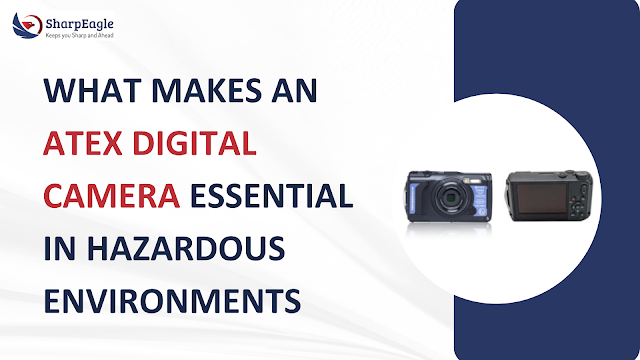Top Benefits of Using an Explosion Proof Digital Camera
In today’s high-risk industrial environments, safety and efficiency are paramount. Industries such as oil and gas, chemical processing, mining, manufacturing, and marine operations face daily hazards, including flammable gases, vapours, dust, and explosive atmospheres. In these settings, even a single spark from conventional electronic equipment can trigger a catastrophic incident. That’s where explosion proof digital cameras come into play.
Explosion proof digital cameras are specifically designed and certified to operate safely in potentially explosive environments. These cameras not only help industries monitor, document, and inspect operations but also protect personnel and assets by preventing equipment-induced accidents. Below, we explore the top benefits of using an explosion proof digital camera in hazardous workplaces.
1. Enhanced Safety Compliance
The primary advantage of explosion proof digital cameras is their strict compliance with global safety standards. These cameras are engineered to meet certifications such as ATEX (Europe), IECEx (global), NEC (USA), and others, ensuring they can operate without posing ignition risks. By using certified cameras, businesses protect their workforce and avoid costly fines or legal actions related to non-compliance with health and safety regulations.
2. Protection Against Extreme Conditions
Explosion proof digital cameras are built to withstand some of the most extreme and demanding conditions on Earth. They are designed with rugged, corrosion-resistant housings that protect the internal electronics from dust, water, vibration, impact, and extreme temperatures. Whether used in offshore oil rigs battered by storms or in dusty mining tunnels, these cameras consistently deliver reliable performance.
3. High-Quality Imaging and Video
Safety and operational efficiency require clear, accurate visual documentation. Explosion proof cameras are equipped with high-resolution sensors and advanced optics to capture crystal-clear images and high-definition video, even in low-light or difficult conditions. This capability allows operators to conduct thorough inspections, detect anomalies, and make informed decisions without exposing personnel to danger.
4. Remote Monitoring Capabilities
Many modern explosion proof digital cameras offer remote access and monitoring features. This is especially valuable in hazardous environments where human access is restricted or unsafe. Through IP connectivity and real-time streaming, personnel can inspect and monitor equipment or processes from a safe distance, reducing the need for manual inspections and minimizing exposure to hazardous conditions.
5. Minimised Operational Downtime
Equipment failures in high-risk industries can lead to costly downtime and dangerous situations. Explosion proof digital cameras enable preventive maintenance by allowing operators to detect early signs of wear, corrosion, or malfunction. By identifying potential issues before they escalate, companies can perform targeted maintenance and avoid unplanned shutdowns, ultimately improving operational efficiency.
6. Versatility of Use
Explosion proof cameras are highly adaptable and can be used for a variety of tasks including inspections, surveillance, documentation, quality control, and even live monitoring of production lines. Their versatility makes them an essential tool across numerous sectors, including petrochemical plants, pharmaceutical facilities, paint manufacturing units, and shipyards.
7. Improved Incident Investigation
In the unfortunate event of an incident, explosion proof cameras provide valuable footage for analysis. This data helps safety teams reconstruct events, identify root causes, and implement corrective actions to prevent recurrence. Detailed visual records also assist in meeting regulatory reporting requirements.
8. Cost-Effectiveness in the Long Term
Although the initial investment in an explosion proof digital camera may be higher than that of a conventional camera, the long-term benefits are significant. These cameras reduce the need for frequent replacements due to damage, prevent costly accidents, minimise downtime, and enhance workplace safety. Over time, this translates into substantial savings for businesses operating in hazardous environments.
9. Compact and User-Friendly Design
Today’s explosion proof cameras are more compact and easier to use than earlier models. They often come with intuitive controls, ergonomic designs, and lightweight bodies, allowing workers to carry and operate them comfortably during inspections or routine checks. Some models even include wireless connectivity and advanced features like thermal imaging or zoom capabilities.
10. Contribution to Digital Transformation
As industries embrace digitalisation and Industry 4.0, explosion proof digital cameras play a critical role in enabling data collection and analysis from hazardous environments. Integrating these cameras into an industrial Internet of Things (IIoT) ecosystem helps companies improve their predictive maintenance strategies, optimise workflows, and enhance overall safety protocols.
Conclusion
The use of explosion proof digital cameras in hazardous industries is no longer optional — it’s essential. From enhancing worker safety to improving operational efficiency and supporting regulatory compliance, the benefits are clear and substantial. By investing in these robust and technologically advanced cameras, companies demonstrate a commitment to protecting both their employees and their business assets.
If your organisation operates in high-risk environments and values safety, durability, and performance, consider exploring SharpEagle’s range of explosion proof digital cameras. Contact us today for a consultation and discover how we can help secure your operations with cutting-edge safety solutions.
.jpg)



Comments
Post a Comment